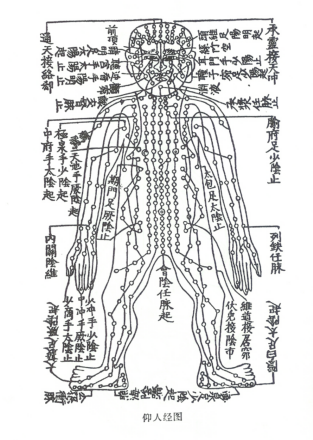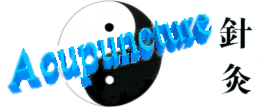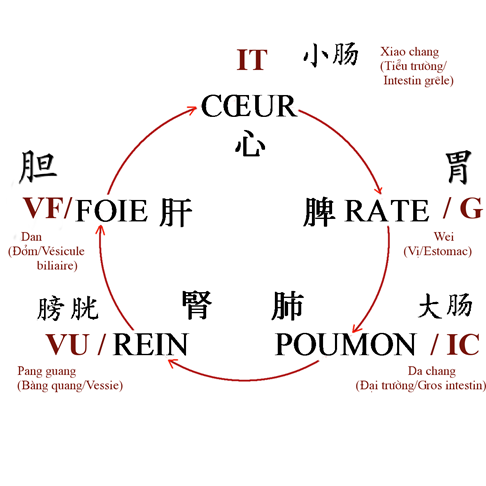Our publications about Acupuncture & Moxibustion
Energetic Meridians

Our publications about Acupuncture & Moxibustion
Energetic Meridians

Cabinet médical
Dr
DAU Quang Luong
224, Avenue du Maine
75014 Paris
Tel. 01 40 44 80 82

The
specialties praticed in our clinic
Acupuncture and Moxibustion
Traditional
Chinese Medicine
Handy Medicine:
Osteopathy
Energetic Massage
Relaxation
Medical Hypnose
Homeopathy
General Medicine
A - THE THEORY OF THE MERIDIANS
The acupuncture is founded on the conviction of the existence of a
meticulous system of meridians in which circulates the biologic energy; it
is about an independent entity as the nervous system, the cardiovascular
system, the lymphatic system.
As one distinguishes the night from the day, the Chinese discern all things
under two aspects: YIN and YANG.
In our organism, the Yin and the Yang are two opposite but complementary
aspects of our biologic energy. When the balance between the Yin and the
Yang is steady, we are in good health. When the harmony between the Yin and
the Yang is disturbed, our health is in danger. This harmony is maintained
in our organism by different energizing systems that one can call ENERGIZING
ORBIS, formed by different energizing channels named MERIDIANS in which
circulates the energy.
In only one energizing orbis one distinguishes two energizing faces, one Yin
and the other Yang. The Yin face is represented by the system of the
meridians Yin assigned to an organ (Yin), while Yang face, by meridians Yang
assigned to a coupled bowel (Yang). The energizing channels of every face
include:
a main meridian,
a distinct meridian,
a sinewy-muscular meridian,
a transverse secondary meridian,
a longitudinal secondary meridian.
To every couple organ (Yin) / bowel (Yang) is assigned an energizing
orbis that means an energizing system. In the whole there are 6 energizing
orbis in our organism.
Thus, for example, in the orbis energizing WOOD (SPRING) we have an organ
Liver (Yin) and a bowel Gall bladder (Yang). The part of the organ (Liver)
has 5 types of meridians; the one of the bowel (Gall bladder), 5 types of
meridians.
The six energizing orbis are:

1 - for energy WOOD:
Liver (organ-Yin) / Gall bladder (bowel - Yang);
2 - for energy FIRE:
a) Heart (organ - Yin) / Small Intestine (bowel - Yang);
b) Pericardium (organ - Yin) / Triple Metabolism (Yang);
3 - for energy SOIL:
Spleen (organ - Yin) / Stomach (bowel - Yang);
4 - for energy METAL:
Lung (organ - Yin) / Large Intestine (bowel - Yang);
5 - for energy WATER:
Kidney (organ - Yin) / Bladder (bowel - Yang).
In all 6 energizing orbis, one counts 60 meridians. But as our body is a
symmetrical entity, we can understand easily that the number of the
meridians correspondents must be 120 (=60x2). To these 120 meridians are
added the meridian Dai Mai (governor), that governs all meridians
Yang of the body and that borders the dorsal face of the spine and the
meridian Jenn Mai (conception) that orders all meridian Yin of the
body and that borders the previous median line of our body. Outside of these
meridians one must add the 6 couples of meridians named Curious,
meridians that, in normal state of our health, don't exist, but that appear
only when we fall sick. In total there are 134 meridians in our body.
The nomenclature of the main meridians and their abstract:
(NB. By the universal character of this topic, I propose to use in this
article a Latin nomenclature. The abstract of the meridian Jenn Mai and the
meridian Dai Mai is formed by the initial of these meridians in Pinyin)
P
= meridianus de Pulmonibus
(Shou Tai Yin Fei Jing): Lung
C
= meridianus de Corde
(Shou Shao Yin Xin Jing): Heart
PC
= meridianus de Pericardio
(Shou Jue Yin Xin Bao Jing): Pericardium
IT
= meridianus de Intestino Tenui
(Shou Tai Yang Xiao Chang Jing): Small Intestin
T
= meridianus de Triplis Calefacientibus
(Shou Shao Yang San Jiao Jing): Triple heater
IC
= meridianus de Intestino Crasso
(Shou Yang Ming Da Chang Jing): Large Intestine
SP
= meridianus de Splene
(Zu Tai Yin Pi Jing): Spleen
R
= meridianus de Renibus
(Zu Shao Yin Shen Jing): Kidney
H
= meridianus de Hepate
(Zu Jue Yin Gan Jing): Liver
VU
= meridianus de Vesica Urinaria
(Zu Tai Yang Pang Guang Jing): Bladder
VF
= meridianus de Vesica Fellea
(Zu Shao Yang Dan Jing): Gall-Bladder
G
= meridianus de Gastrio
(Zu Yang Ming Wei Jing): Stomach
RM
= meridianus de conceptione
(Jenn Mai): Meridian of conception
DM
= meridianus de gubernando
(Dai Mai): Governor's meridian.
B - THE RELATIONS BETWEEN THE MAIN MERIDIANS AND THE SENSE
OF THE ENERGIZING CIRCULATION
1 - Relations between the main meridians of the same nature:
a) The main meridians Yang of the arms and those of the legs are united in
the high part of the body, to the level of the head (union n° 2 of the
illustration), and the sense of the energizing circulation goes from the
meridians of the arms toward those of the legs:
IT
-->
VU
T
-->
VF
IC
--> G
b) The main meridians Yin of the legs and those of the arms are united in
the high part of the body, to the level of the chest (union n° 3 of the
illustration), and the sense of the energizing circulation goes from the
meridians of the legs toward those of the arms:
SP
-->
P
R -->
C
H -->
PC
2 - Relations between the main meridians of opposite nature:
The Yin-Yang couples of the main meridians is those that form the energizing
orbis.
a) The Yin-Yang couples of the main meridians of the arms are united to the
level of the hand, to the angles of the roots of nails of the fingers (union
n° 1 of the illustration), and the sense of the energizing circulation goes
from the meridian Yin toward the Yang:
P
--> IC
PC
--> T
C
-->
IT
b) The Yin-Yang couples of the main meridians of the legs are united to the
level of the foot, to the angles of the roots of nails of the toes (union n°
4 of the illustration), and the sense of the energizing circulation goes
from meridians Yang toward the meridian Yin:
G
-->
SP
VU-->
R
VF-->
H
Here is the sense of the circulation of the energy in the main meridians of
our organism:
P--->
IC--->
G--->
SP--->
C--->
IT--->
VU--->
R---->
PC--->
T--->
VF--->
H

C - THE RELATIONS BETWEEN THE MAIN MERIDIANS ACCORDING TO
THEIR DEPTH
1 - THE MERIDIANS YANG.
A) TAI YANG: the meridian Tai Yang is superficial and they open up
toward the outside:
Zu Tai Yang (VU = Bladder)
Shou Tai Yang (IT = Small Intestine);
B) SHAO YANG: the meridian Shao Yang has a role of hinge between Tai
Yang and the Yang Ming; they occupy an intermediate zone:
Zu Shao Yang (VF = Gall bladder)
Shou Shao Yang (T = Triple Metabolism);
C) YANG MING: the meridians Yang Ming is in depth and they open up
toward the inside:
Zu Yang Ming (G = Stomach)
Shou Yang Ming (IC = Large Intestine);
2 - THE MERIDIANS YIN.
A) TAI YIN: the meridian Tai Yin are superficial and they open up
toward the outside:
Zu Tai Yin (SP = Spleen)
Shou Tai Yin (P = Lung);
B) SHAO YIN: the meridian Shao Yin are in depth and they open up
toward the inside:
Zu Shao Yin (R = Kedney)
Shou Shao Yin (C = Heart)
C) JUE YIN: the meridian Jue Yin have a role of hinge between the Tai
Yin and the Shao Yin; they occupy an intermediate zone, exception made for
the Zu Jue Yin (H=Liver) because in this organ finishes the energizing
cycle:
Zu Jue Yin (H = Liver)
Shou Jue Yin (PC = Pericardium).